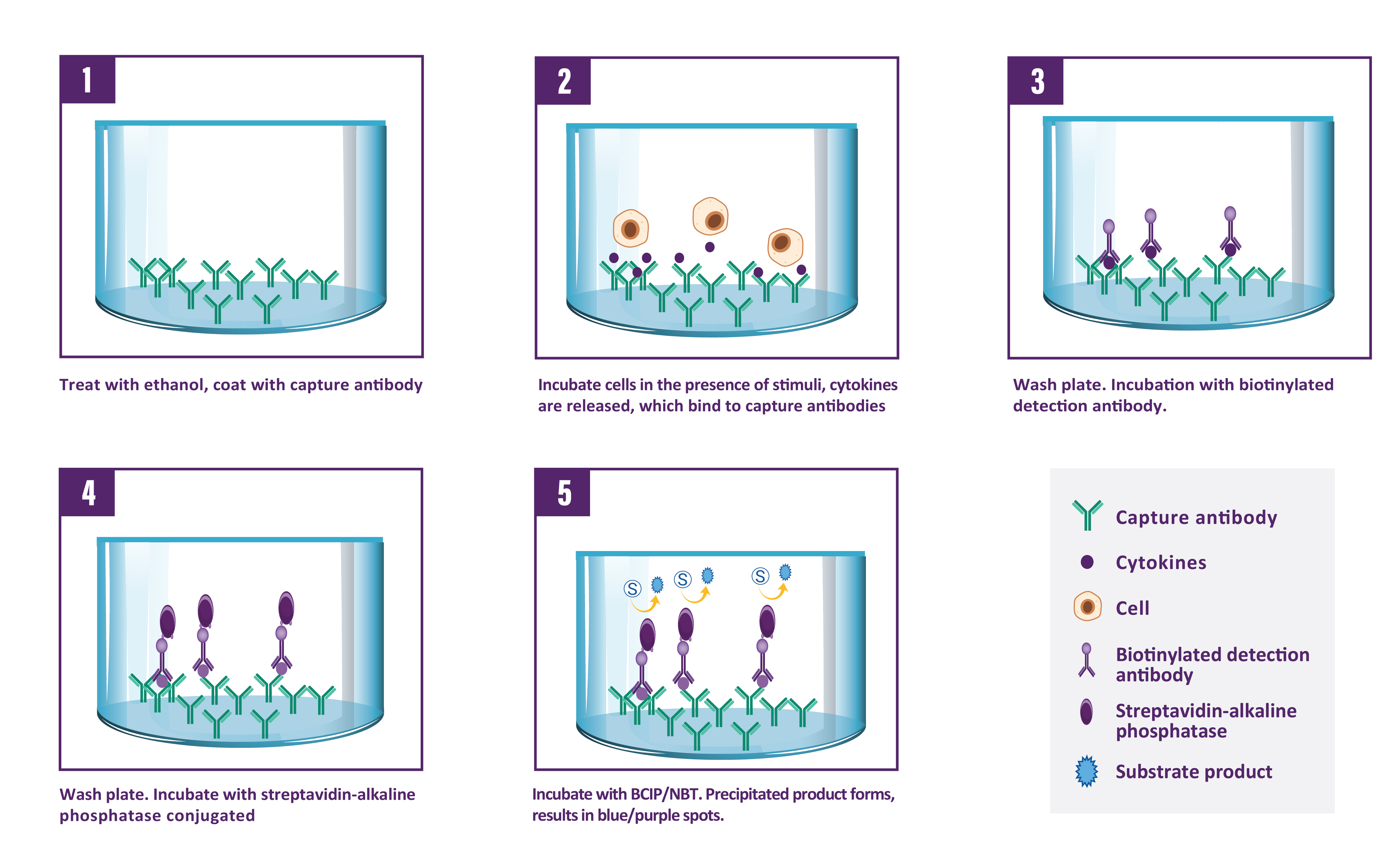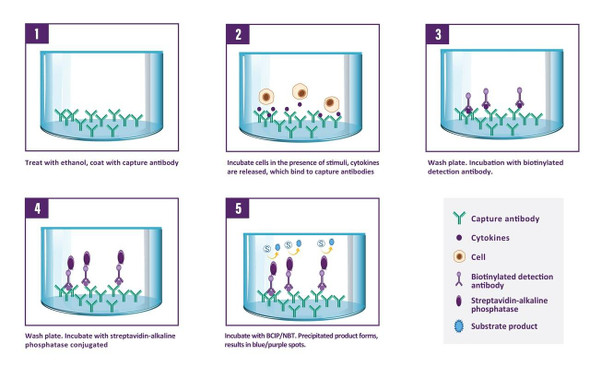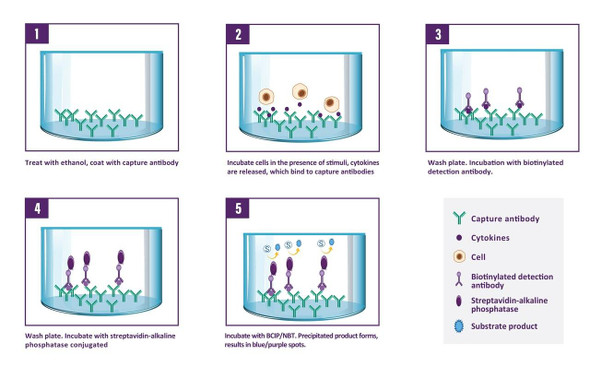Description
Human IL-12p70 ELISpot Pair
Assay Genie ELISpot is a highly specific immunoassay for the analysis of IL-12p70 production and secretion from T-cells at a single cell level in conditions closely comparable to the in-vivo environment with minimal cell manipulation. This technique is designed to determine the frequency of IL-12p70 producing cells under a given stimulation and the comparison of such frequency against a specific treatment or pathological state. Utilising sandwich immuno-enzyme technology, Assay Genie ELISpot assays can detect both secreted IL-12p70 (qualitative analysis) and single cells that produce IL-12p70 (quantitative analysis). Cell secreted IL-12p70 is captured by coated antibodies avoiding diffusion in supernatant, protease degradation or binding on soluble membrane receptors. After cell removal, the captured IL-12p70 is revealed by tracer antibodies and appropriate conjugates.
| Product type: | ELISpot Pairs |
| Size: | 10 x 96 Assays |
| Target species: | Human |
| Specificity: | Recognizes natural human IL-12p70 |
| Incubation: | |
| Kit content: | Assay Genie ELISpot matched antibody pairs are extensively validated and include pre-titrated capture antibody and biotinylated detection antibody. Antibodies are supplied in quantities sufficient for 10 x 96 samples. |
| Synonyms: | IL-12 |
| Uniprot: | P29460 |
A capture antibody highly specific for IL-12p70 is coated to the wells of a PVDF bottomed 96 well microtitre plate either during kit manufacture or in the laboratory. The plate is then blocked to minimise any non-antibody dependent unspecific binding and washed. Cell suspension and stimulant are added and the plate incubated allowing the specific antibodies to bind any IL-12p70 produced. Cells are then removed by washing prior to the addition of Biotinylated detection antibodies which bind to the previously captured IL-12p70. Enzyme conjugated streptavidin is then added binding to the detection antibodies. Following incubation and washing, substrate is then applied to the wells resulting in coloured spots which can be quantified using appropriate analysis software or manually using a microscope.

| Step | Procedure |
| 1. | Add 100 µl of PBS 1X to every well. |
| 2. | Incubate plate at room temperature (RT) for 10 min. |
| 2. | Incubate plate at room temperature (RT) for 10 min. |
| 3. | Empty the wells by flicking the plate over a sink & gently tapping on absorbent paper. |
| 3. | Empty the wells by flicking the plate over a sink & gently tapping on absorbent paper. |
| 4. | Add 100 µl of sample, positive and negative controls cell suspension to appropriate wells providing the required concentration of cells and stimulant. |
| 5. | Cover the plate and incubate at 37°C in a CO2 incubator for an appropriate length of time (15-20 hours). Note: do not agitate or move the plate during this incubation. |
| 6. | Empty the wells and remove excess solution then add 100 µl of Wash Buffer to every well. |
| 7. | Incubate the plate at 4°C for 10 min. |
| 8. | Empty the wells as previous and wash the plate 3x with 100 µl of Wash Buffer. |
| 9. | Add 100 µl of diluted detection antibody to every well. |
| 10. | Cover the plate and incubate at RT for 1 hour 30 min. |
| 11. | Empty the wells as previous and wash the plate 3x with 100 µl of Wash Buffer. |
| 12. | Add 100 µl of diluted Streptavidin-AP conjugate to every well. |
| 13. | Cover the plate and incubate at RT for 1 hour. |
| 14. | Empty the wells and wash the plate 3x with 100 µl of Wash Buffer. |
| 15. | Peel of the plate bottom and wash both sides of the membrane 3x under running distilled water, once washing is complete remove any excess solution by repeated tapping on absorbent paper. |
| 16. | Add 100 µl of ready-to-use BCIP/NBT buffer to every well. |
| 17. | Incubate the plate for 5-15 min monitoring spot formation visually throughout the incubation period to assess sufficient colour development. |
| 18. | Empty the wells and rinse both sides of the membrane 3x under running distilled water. Completely remove any excess solution by gentle repeated tapping on absorbent paper. |
| 19. | Read Spots: allow the wells to dry and then read results. The frequency of the resulting coloured spots corresponding to the cytokine producing cells can be determined using an appropriate ELISpot reader and analysis software or manually using a microscope. Note: spots may become sharper after overnight incubation at 4°C in the dark. |
| UniProt Protein Function: | IL12B: Cytokine that can act as a growth factor for activated T and NK cells, enhance the lytic activity of NK/lymphokine- activated killer cells, and stimulate the production of IFN-gamma by resting PBMC. Defects in IL12B are a cause of mendelian susceptibility to mycobacterial disease (MSMD); also known as familial disseminated atypical mycobacterial infection. This rare condition confers predisposition to illness caused by moderately virulent mycobacterial species, such as Bacillus Calmette-Guerin (BCG) vaccine and environmental non-tuberculous mycobacteria, and by the more virulent Mycobacterium tuberculosis. Other microorganisms rarely cause severe clinical disease in individuals with susceptibility to mycobacterial infections, with the exception of Salmonella which infects less than 50% of these individuals. The pathogenic mechanism underlying MSMD is the impairment of interferon-gamma mediated immunity, whose severity determines the clinical outcome. Some patients die of overwhelming mycobacterial disease with lepromatous-like lesions in early childhood, whereas others develop, later in life, disseminated but curable infections with tuberculoid granulomas. MSMD is a genetically heterogeneous disease with autosomal recessive, autosomal dominant or X-linked inheritance. Genetic variations in IL12B are a cause of susceptibility to psoriasis type 11 (PSORS11). Psoriasis is a common, chronic inflammatory disease of the skin with multifactorial etiology. It is characterized by red, scaly plaques usually found on the scalp, elbows and knees. These lesions are caused by abnormal keratinocyte proliferation and infiltration of inflammatory cells into the dermis and epidermis. Belongs to the type I cytokine receptor family. Type 3 subfamily. |
| UniProt Protein Details: | Protein type:Secreted; Cytokine; Secreted, signal peptide Chromosomal Location of Human Ortholog: 5q31.1-q33.1 Cellular Component: extracellular space; membrane; interleukin-12 complex; cytoplasm Molecular Function:hematopoietin/interferon-class (D200-domain) cytokine receptor activity; identical protein binding; interleukin-12 alpha subunit binding; protein binding; protein homodimerization activity; growth factor activity; protein heterodimerization activity; interleukin-23 receptor binding; cytokine activity; interleukin-12 receptor binding Biological Process: positive regulation of granulocyte macrophage colony-stimulating factor production; positive regulation of cell adhesion; positive regulation of T-helper 1 type immune response; negative regulation of interleukin-10 production; positive regulation of T cell mediated cytotoxicity; negative regulation of smooth muscle cell proliferation; positive regulation of interleukin-12 production; positive regulation of osteoclast differentiation; positive regulation of NK T cell proliferation; positive regulation of tyrosine phosphorylation of Stat4 protein; natural killer cell activation; positive regulation of NF-kappaB import into nucleus; sensory perception of pain; defense response to Gram-negative bacterium; positive regulation of activated T cell proliferation; positive regulation of interleukin-10 production; positive regulation of natural killer cell activation; positive regulation of tyrosine phosphorylation of Stat3 protein; positive regulation of lymphocyte proliferation; natural killer cell activation during immune response; positive regulation of T cell proliferation; negative regulation of inflammatory response to antigenic stimulus; cell cycle arrest; defense response to virus; regulation of cytokine biosynthetic process; positive regulation of memory T cell differentiation; positive regulation of interleukin-17 production; positive regulation of natural killer cell proliferation; cell migration; T-helper 1 type immune response; positive regulation of NK T cell activation; T-helper cell differentiation; positive regulation of natural killer cell mediated cytotoxicity directed against tumor cell target; cytokine and chemokine mediated signaling pathway; defense response to protozoan; positive regulation of tumor necrosis factor production; regulation of tyrosine phosphorylation of Stat1 protein; response to UV-B; positive regulation of tissue remodeling; positive regulation of interferon-gamma production; negative regulation of interleukin-17 production; positive regulation of mononuclear cell proliferation; positive regulation of tyrosine phosphorylation of Stat5 protein; sexual reproduction; interferon-gamma biosynthetic process; positive regulation of defense response to virus by host; positive regulation of inflammatory response; positive regulation of interferon-gamma biosynthetic process Disease: Immunodeficiency 29 |
| NCBI Summary: | This gene encodes a subunit of interleukin 12, a cytokine that acts on T and natural killer cells, and has a broad array of biological activities. Interleukin 12 is a disulfide-linked heterodimer composed of the 40 kD cytokine receptor like subunit encoded by this gene, and a 35 kD subunit encoded by IL12A. This cytokine is expressed by activated macrophages that serve as an essential inducer of Th1 cells development. This cytokine has been found to be important for sustaining a sufficient number of memory/effector Th1 cells to mediate long-term protection to an intracellular pathogen. Overexpression of this gene was observed in the central nervous system of patients with multiple sclerosis (MS), suggesting a role of this cytokine in the pathogenesis of the disease. The promoter polymorphism of this gene has been reported to be associated with the severity of atopic and non-atopic asthma in children. [provided by RefSeq, Jul 2008] |
| UniProt Code: | P29460 |
| NCBI GenInfo Identifier: | 266320 |
| NCBI Gene ID: | 3593 |
| NCBI Accession: | P29460.1 |
| UniProt Related Accession: | P29460 |
| Molecular Weight: | 37,169 Da |
| NCBI Full Name: | Interleukin-12 subunit beta |
| NCBI Synonym Full Names: | interleukin 12B |
| NCBI Official Symbol: | IL12BÂ Â |
| NCBI Official Synonym Symbols: | CLMF; NKSF; CLMF2; IMD28; IMD29; NKSF2; IL-12BÂ Â |
| NCBI Protein Information: | interleukin-12 subunit beta; CLMF p40; IL-12 subunit p40; IL12, subunit p40; interleukin 12, p40; interleukin-12 beta chain; NK cell stimulatory factor chain 2; cytotoxic lymphocyte maturation factor 40 kDa subunit; natural killer cell stimulatory factor, 40 kD subunit; interleukin 12B (natural killer cell stimulatory factor 2, cytotoxic lymphocyte maturation factor 2, p40) |
| UniProt Protein Name: | Interleukin-12 subunit beta |
| UniProt Synonym Protein Names: | Cytotoxic lymphocyte maturation factor 40 kDa subunit; CLMF p40; IL-12 subunit p40; NK cell stimulatory factor chain 2; NKSF2 |
| UniProt Gene Name: | IL12BÂ Â |
| UniProt Entry Name: | IL12B_HUMAN |






